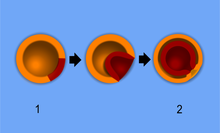Gastrulation
The English used in this article or section may not be easy for everybody to understand. (October 2022) |
EDITED BY ONYANGO RISPER ATIENO EHS/00100/022 AND THE FOLLOWING MEMBERS [1]
1.JOY KEMBOI EHS/00123/022
2.JASON KAGUTHIA EEC/00081/021
3.MUSYOKA LILIAN KAVINDI EHS/00099/022
4.KHISA KHALAYI CHRISTINE EHS/00099/022

Gastrulation is a phase early in the development of most animal embryos. In it, the embryo is dramatically restructured by cell migration.
Gastrulation varies in different phyla. It is followed by organogenesis, when individual organs develop within the newly formed germ layers.
The gastrula is the double-walled stage of the embryo. During gastrulation, some of the cells of the blastula migrate inwards to make an inner layer, the endoderm. In some animals another cell layer forms, the mesoderm, between the endoderm and the ectoderm.
layer
[change | change source]ls, sponges show the simplest organization, having a single germ layer. Cnidaria and ctenophores show an increase in complexity, having two germ layers, the endoderm and ectoderm. All higher animals (from flatworms to humans) possess a mesoderm as well as ectoderm and endoderm.
Development of germ layers
The purpose of gastrulation is to position the 3 embryonic germ layers, the endoderm, ectoderm and mesoderm. These layers later develop into certain bodily systems.
- The ectoderm develops into the skin, nails, the epithelium of the nose, mouth and anal canal; the lens of the eye, the retina and the nervous system.
- The endoderm develops into the inner linings of the digestive tract, as well as the linings of the respiratory passages. It also forms many glands, such as the liver and pancreas.
- The mesoderm forms the somites, the notochord, and the mesenchyme, which give rise to the muscles, circulatory and excretory systems of the body. This key innovation evolved hundreds of millions of years ago and led to the evolution of nearly all large, complex animals. The formation of a mesoderm led to the development of a coelom. Organs formed inside a coelom can freely move, grow, and develop independently of the body wall while fluid cushions and protects them from shocks.[1]
Related pages
[change | change source]References
[change | change source]- ↑ 1.0 1.1 Evers, Christine A. Lisa Starr. 2006. Biology: concepts and applications. 6th ed, Thomson. ISBN 0-534-46224-3.
